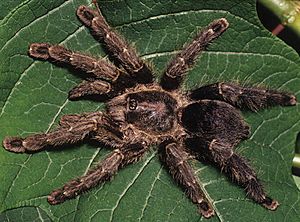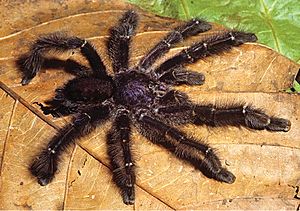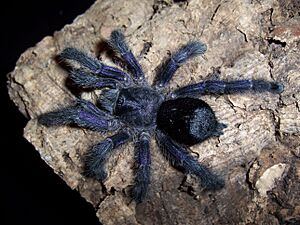Purple tree tarantula facts for kids
Quick facts for kids Purple tree tarantula |
|
|---|---|
 |
|
| Female, southern form | |
 |
|
| Male, southern form | |
| Scientific classification |
The purple tree tarantula (scientific name: Avicularia purpurea) is a fascinating type of spider. It's part of the Theraphosidae family, which is the group of spiders we call tarantulas. This amazing creature is also known as the Ecuadorian purple tarantula or Ecuador purple pinktoe because of its beautiful colors.
Contents
Where Do Purple Tree Tarantulas Live?
These special spiders mostly live in Ecuador, a country in South America. You can find them in the Amazon Region of Ecuador.
What Is Their Home Like?
Purple tree tarantulas can live in many different places. They often live in areas where people farm, especially where cattle graze. Sometimes, you might even find them in holes in building walls or under roofs!
How to Spot a Purple Tree Tarantula
An Avicularia purpurea tarantula can grow to be about 13 centimetres (5.1 in) long. That's about the size of your hand!
In daylight, this spider shows off a bright purple-blue shimmer. This color is on its head and chest area (called the cephalothorax), its legs, and its mouthparts (palps and chelicerae). The long hairs covering its legs and palps are a dark red-brown color. The tips of its legs have very dark brown pads, and its foot tufts are a pale cream-pink. Its body (abdomen) is velvet-black and covered with special stinging hairs.
Purple Tree Tarantula Behavior
The Avicularia purpurea is mostly an arboreal spider. This means it loves to climb and spend its time in trees! It builds its nests inside hollows in trees. Sometimes, it even makes its home near plants that grow on other plants, called epiphytic plants.
What Do They Eat?
These tarantulas are hunters. They mostly eat insects like crickets, cockroaches, mealworms, waxworms, and darkling beetles. Sometimes, they can even catch small rodents!
Reproduction and Life Cycle
When it's time to mate, female tarantulas can become very protective and aggressive towards the males. A few months after mating, the female will lay her eggs. She can lay up to 120 eggs inside a special silk cocoon. About six to eight weeks later, between 50 and 120 baby tarantulas, called nymphs, will hatch from the eggs.
See also
 In Spanish: Avicularia purpurea para niños
In Spanish: Avicularia purpurea para niños


